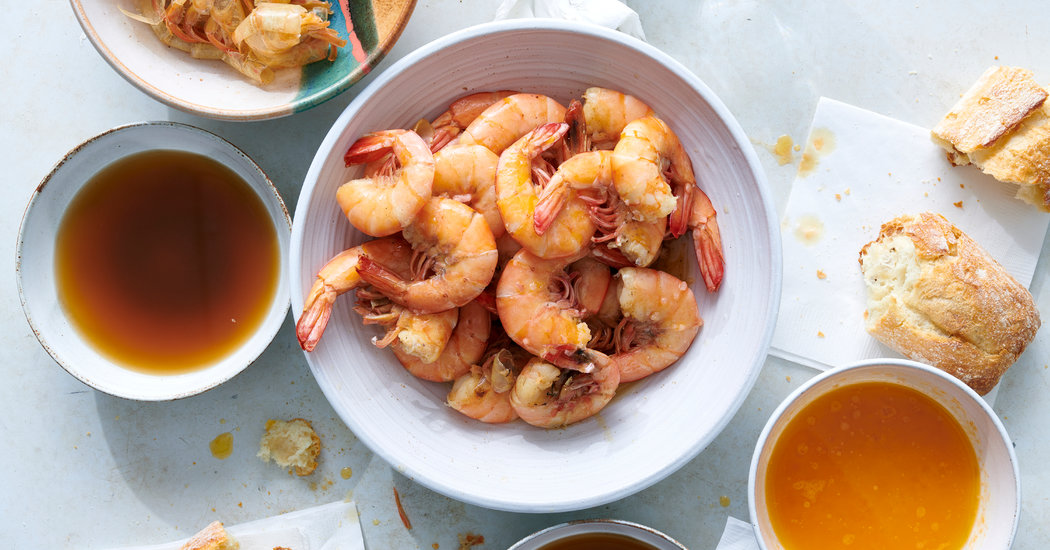
Good morning. What are we supposed to think about shrimp? That’s the question we asked Melissa Clark a few months ago, wondering which shrimp we ought to buy for our pla goong, our jambalaya, our favorite pizza. We were worried about the farming practices that brought some shrimp to market, the labor of enslaved people, the diseases, the antibiotics, the pollution. We didn’t know: Should we eat wild shrimp, farmed shrimp, expensive shrimp, inexpensive shrimp?
Melissa set to work reporting and her answers to our questions appear in The Times today, the centerpiece of the Wednesday report we publish online and fold into blue bags to deliver to print subscribers. It’s a rich story filled with details, and I want you to read every word, but I’ll offer an executive summary all the same: Eat shrimp, not too often, mostly expensive.
Of course there are some recipes to go along with the work Melissa did in the field: a sheet-pan shrimp scampi; a spicy shrimp boil with lemon butter (above); and coconut-lime shrimp. Make those with the right sort of shrimp — caught in the American wild and flash-frozen, for instance — and you’ll eat deliciously and sleep well afterward.
It’s not for shrimp, but Yotam Ottolenghi gave us a terrific new recipe this week as well, for a butternut squash and fondue pie with pickled red chiles. Or, if you’d like a delicious project, Charlotte Druckman figured out how the Swedish bakery Fabrique, in the meatpacking district of Manhattan, makes its ridiculously good cardamom bun. Then she developed a recipe for home cooks.
You could make creamy chickpea pasta with spinach and rosemary this week. You could bake maple-walnut blondies, give them to someone kind. You could, at last, try your hand at this pan-roasted chicken in cream sauce, which calls for spring morels but is awesome with oyster mushrooms or hen of the woods.
Or you could as we often do on Wednesdays in this space, cook without a recipe, using only a few prompts to make your way from kitchen to table.
So, for instance, chicken teriyaki, which you can serve over rice with some slivered scallions, with steamed broccoli on the side or mixed into the sauce with the chicken. It’s easy. Dust some boneless, skinless chicken thighs with kosher salt and a tablespoon or so of all-purpose flour. Brown these in a sauté pan with a few tablespoons of neutral oil, working in batches to avoid crowding the pan. Then, as the chicken cooks, make a sauce of equal parts sake and mirin, with soy sauce and sugar to taste, and add it to the pan with the chicken. Allow it to cook over medium-high heat, mixing occasionally, until it gets a little syrup-y and the chicken is cooked entirely through. This is really, really good.
Thousands of actual recipes to cook tonight or this week are available on NYT Cooking, though you will need a subscription to access them. (Here’s a thought as we head into the holidays: You can get gift subscriptions as well!)
Come visit us for free, though, on Facebook and Instagram, Twitter and YouTube.
And if you find yourself in trouble with a recipe or your account, please ask us for help: cookingcare@nytimes.com. We will get back to you. (You can reach me directly, if you like, at foodeditor@nytimes.com.)
Now, see what you make of Eric Asimov’s reporting this week on wine and climate change — how it’s changing the latitudes at which certain wines can be made, how it’s forcing growers to higher altitudes and onto slopes with less direct heat from the sun, how it’s sparking experimentation and causing unpredictable and dangerous weather that puts vineyards in peril.
You should read Kim Severson, as well, on the pasta grannies of YouTube fame.
And while it has nothing to do with food, you should also read Susannah Jacob on what’s happened to the West Village in Manhattan, in The New York Review of Books, with photographs by Radcliffe Roye. Do that, make the teriyaki, and I’ll see you on Friday.




